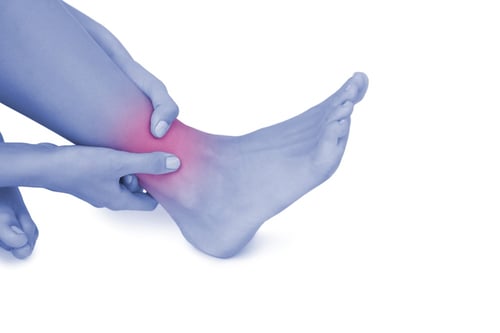What Does It Mean to Roll Your Ankle?

When someone injures their ankle, they often say they have “rolled their ankle”, but what does that mean? We will take a look at what happens when you roll your ankle and discuss how to treat such an injury.
Rolled Ankle = Sprained Ankle
The phrase “rolled ankle” is commonly used when a person experiences an ankle sprain. Since the injury was caused by a rolling motion, some people will commonly say they “rolled their ankle” instead of saying they sprained it.
What is a Sprained Ankle?
A sprained ankle typically occurs as a result of a rolling motion of the foot. When the foot rolls, it stretches the ligaments of the ankle. If the ligaments are stretched too much, they can tear or even become completely detached from the bone. This can cause you to experience extreme pain, discomfort and even result in additional foot and ankle problems.
The Different Types of Ankle Sprains
There are three types of ankle sprains. The type of ankle sprain you experience depends upon what ligaments are injured. The three types of ankle sprains are:
- Lateral Ankle Sprain – a stretching or tearing of the ligaments on the outside of the ankle. Typically happens as a result of the foot rolling inwards.
- Medial (Eversion) Ankle Sprain – a stretching or tearing of the ligaments on the inside of the ankle. Typically happens when the foot rolls outwards. Medial ankle sprains are less common than lateral ankle sprains.
- High Ankle Sprain – a stretching or tearing of the ligaments just above the ankle bone which are used to connect the shin bones together. A high ankle sprain typically happens as a result of a sudden shift or change in direction or from an ankle fracture.
In addition to the type of ankle sprain, most ankle sprains are given a grade. The grade provides you with a better understanding of the severity of the injury.
The three types of grades for ankle sprains are:
- Grade 1 – a minor sprain that usually involves a stretching of the ligaments or very minor/small tears. Typically causes pain, stiffness and swelling.
- Grade 2 – a moderate sprain that is caused by a partial tearing of the ligament. Symptoms of grade 2 sprains include moderate pain and swelling.
- Grade 3 – a severe sprain that results from the complete tearing of the ligament or a complete detachment of the ligament from the bone. Symptoms of a grade 3 sprain include intense pain, ankle instability, and severe swelling.
Treatment for Ankle Sprains
Immediate treatment of an ankle sprain can help reduce pain, stiffness and swelling. If you believe you have sprained your ankle, follow the R.I.C.E treatment protocol. The R.I.C.E treatment is:
- Rest – avoid standing and walking on the injured foot or ankle immediately after injury.
- Ice – apply ice or cold compresses for 20 minutes to reduce swelling and help with pain. Follow the rule of 20 minutes on, 20 minutes off.
- Compression – use a bandage to wrap the ankle. This helps reduce swelling.
- Elevate – try to keep the injured ankle in an up position. It is recommended that the ankle try to be above heart level to help reduce swelling.
Most ankle sprains can be treated with the use of the R.I.C.E method. However, surgery may be required for severe ankle sprains where the ligament has been severely damaged or it has been completely removed from the bone. A foot specialist can help assess your injury to determine if surgery may be needed.
Early Treatment of Ankle Sprains Prevents Serious Problems
Even though most ankle sprains can be treated with things you can do at home, it is still important to make an appointment with one of our doctors at Sweeney Foot and Ankle. Early treatment of ankle sprains can help you prevent serious problems from occurring in the future.
Our doctors at Sweeney Foot & Ankle can assess your injury and make sure it is being properly treated. Treatment for ankle sprains depends upon its severity and can range from rest and elevation to splinting, wearing a CAM boot, or even surgery.
Contact us to schedule an appointment to speak with our foot specialist about your ankle sprain.






